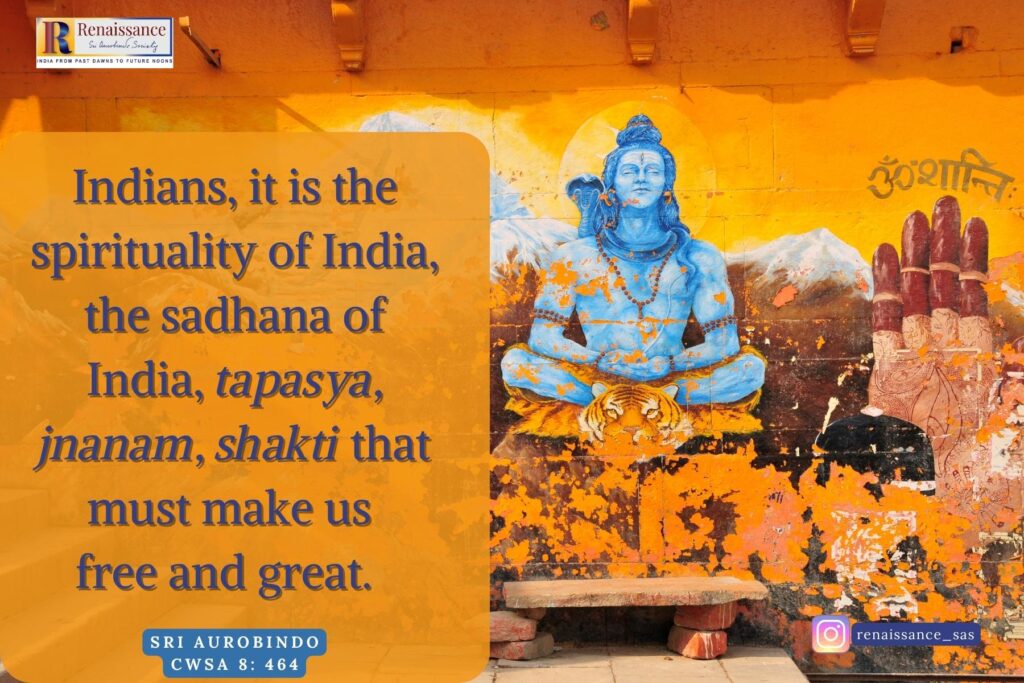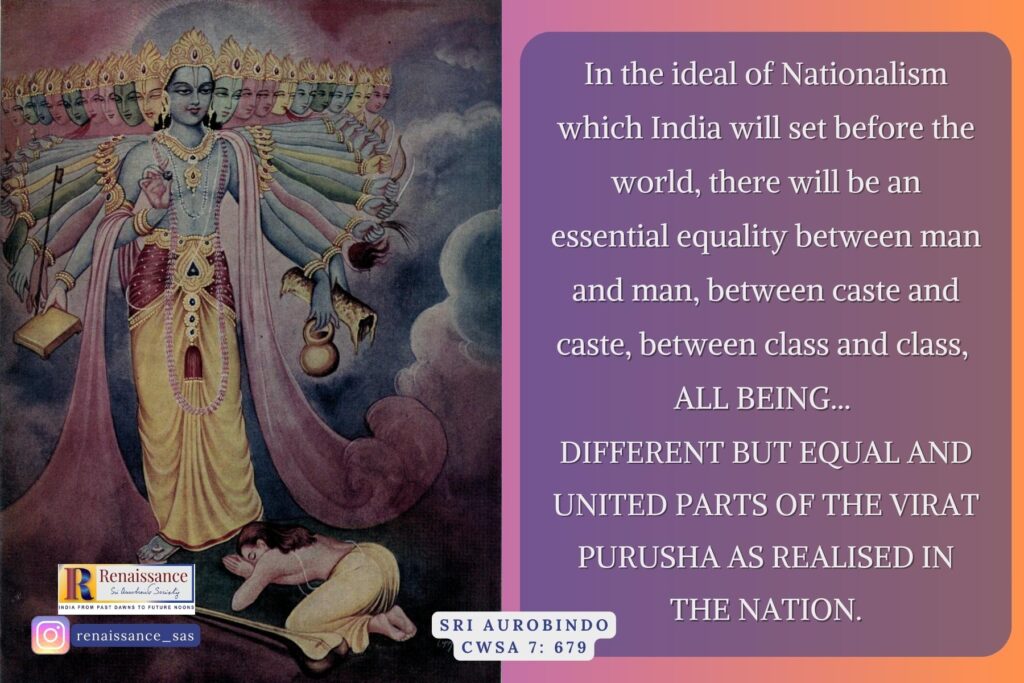Sri Aurobindo reminds us that if we have to be reborn as a society, as a nation, if we have to raise ourselves to work toward the true mission of India, to fulfill India’s true destiny, we must grow in Shakti. What is truly necessary to make Indians, and especially the youth of India grow in Shakti? One obvious answer is: an education that helps build their capacities and capabilities.
When rethinking education and its role in shaping the India of tomorrow, it is critical to have a deep understanding of the fundamentals which shaped the ancient Indian view of education and life. Without a grounding in the essentials which formed the basis of the glorious educational heritage of India, we can’t be certain of the educational vision and policy which will help us build an even more glorious future.
Back to Basics
We hear and read of some attempts being made to revive the old gurukula system of education. But before we can ask the question whether such an attempt is feasible or even desirable in present times, we must first discover the essential ideas and principles which formed the basis of the ancient Indian educational thought and practice, including the gurukula system.
The first question to ask is about the aim of education. To truly know oneself is the key to knowing all—this truth revealed by Indian seers and sages was at the core of Indian view of education.
This is why we find in Indian spiritual literature great treatises dedicated to understanding what essentially is a human being. The yogis and munis were spiritual psychologists who dug deep into uncovering the secrets of different parts or layers of a human being and their interconnections. They also experimented and perfected various practices to help develop, refine and perfect these various parts.
Education is a field of human activity concerned with knowledge of the world and the self, as well as the process of knowing the world and the self. An aim of facilitating genuine self-awareness and gradual self-mastery and self-perfection must inform the blueprint of education for a true Indian renaissance.
* * *
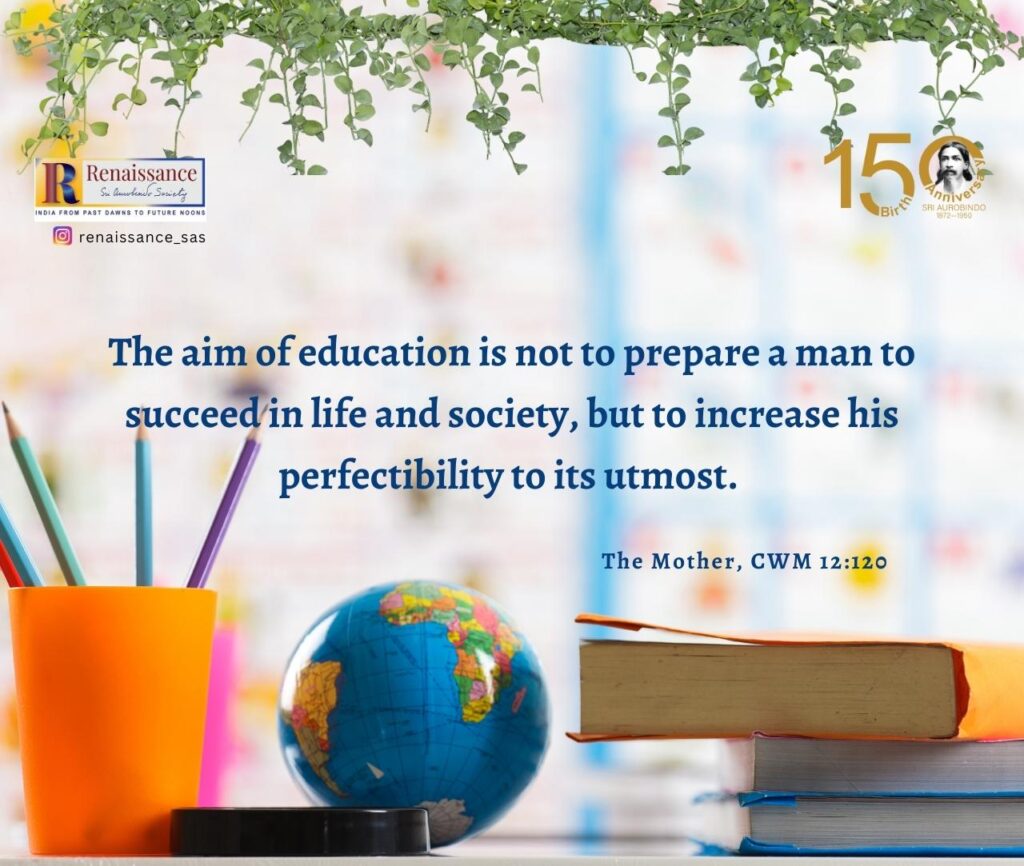
* * *
There is also a need to identify the fundamentals that served as the foundation of a mighty intellectual superstructure in the past. Only then we might be able to create new structures and institutions which while being based on those essential principles will be more appropriate for our times. Sri Aurobindo points us to the core in this regard:
What was the secret of that gigantic intellectuality, spirituality and superhuman moral force which we see pulsating in the Ramayana and Mahabharata, in the ancient philosophy, in the supreme poetry, art, sculpture and architecture of India? What was at the basis of the incomparable public works and engineering achievements, the opulent and exquisite industries, the great triumphs of science, scholarship, jurisprudence, logic, metaphysics, the unique social structure?
What supported the heroism and self-abandonment of the Kshatriya, the Sikh and the Rajput, the unconquerable national vitality and endurance? What was it that stood behind that civilisation second to none in the massiveness of its outlines or the perfection of its details? Without a great and unique discipline involving a perfect education of soul and mind, a result so immense and persistent would have been impossible. It would be an error to look for the secret of Aryan success in the details of the instruction given in the old ashrams and universities so far as they have come down to us.
We must know what was the principle and basis on which the details were founded. We shall find the secret of their success in a profound knowledge of human psychology and its subtle application to the methods of intellectual training and instruction.
~ CWSA, Vol. 1, p. 369
The essential principle on which a great intellectual superstructure can be built, that fundamental basis of the ancient vision of true education of soul and mind, according to Sri Aurobindo, was the all-important discipline of brahmacharya. This discipline helped provide a strong foundation for all the stupendous and rich activity ancient India witnessed in all spheres – spiritual, intellectual, vital, aesthetic, economic and organisational.
* * *
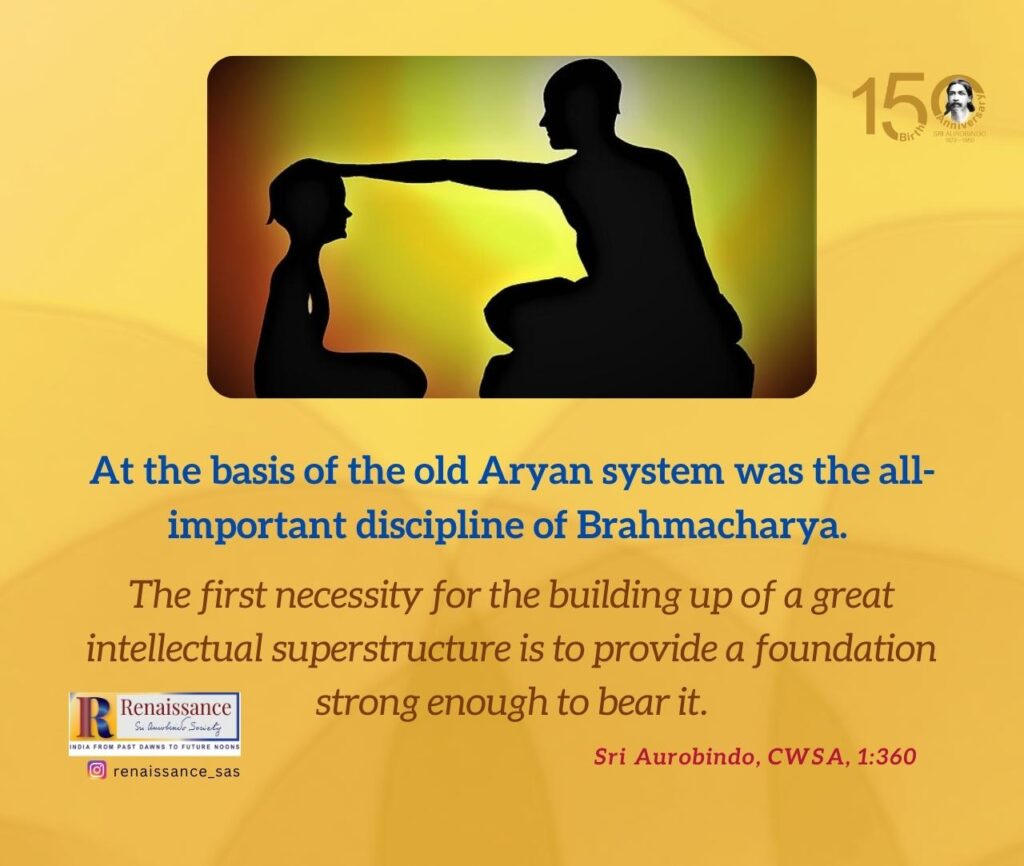
* * *
Brahmacharya, the Student Stage
Brahmacharya, as is commonly known, was also the name given in the Indian tradition to the first of the four ashramas or stages of human life, with grihastha (householder), vānaprastha (forest dweller), and sannyasa (renunciation) being the other three. In this context, the word brahmacharya referred to the stage when an unmarried student was focused on his or her education, training in some specialized knowledge and preparing for a vocation.
In this stage, celibacy was emphasised as part of the discipline necessary for a student. This discipline was imposed because it helped conserve the students’ energies and helped them remain focused on their immediate goal of mastering their studies. The teacher or guru was regarded as Brahman in human form, and the student was referred to as brahmachārin, follower of Brahma or Brahman.
Generally, people in the first 25 years of their lives would go through this formal student stage.
Some ancient dharmashāstra-s suggest that the brahmacharya stage of life should extend from when a child is ready to receive teachings from a guru and continue for a period of at least twelve years. As per the Manusmriti, this period could range from between 9 to 36 years, till the student has mastered his subject.
The general practice was that upon the child’s upanayana samskāra, the young person would begin a life of study in the gurukula (the household of the guru). The studies were meant to inculcate in the young mind all the values of dharmic living, the righteous living.
At the same time the goal was to prepare the individual for a vocation suitable to his/her inner temperament and aptitude. This meant directing the learner’s studies in various śāstra-s related to subjects of his or her interest. Learners were also given sufficient grounding in spiritual scriptures such as some parts of the Vedas and Upanishads. During this long period, the students were expected to lead austere and highly disciplined lives. This stage of life was characterised by the practice of celibacy. It is important to note that sufficient evidence suggests that in ancient India the education of girls was never ignored [See HERE].
Also, no restriction of age to pursue learning was present in ancient India. Often older people aspiring for higher learning also sought teachers who were authorities in certain areas of knowledge, particularly spiritual knowledge and realisation of ātman, inner Self, and Brahman, the Ultimate Reality.
For example, in section 5.11 of the Chandogya Upanishad we meet five adults – all wealthy householders and great scholars, who approached a sage named Uddalaka Aruni to learn from about Self and Brahman. Admitting his deficient knowledge, Uddalaka suggests that they all go to King Asvapati Kaikeya for gaining this knowledge.
The graduation from the brahmacharya stage of life was marked by the samāvartana ceremony. The snātak (graduate) was then ready to either start the householder stage of life. Or if he or she wished, he may pursue a life of sannyasa and solitude. In the Taittiriya Upanishad (Shikshavalli, I:11:1) we find a valuable advice given by the guru at the completion of studies. This emphasises speaking the truth, living a dharmic life, practicing right virtues, continuing self-study and study of the spiritual scriptures and many other things.
* * *
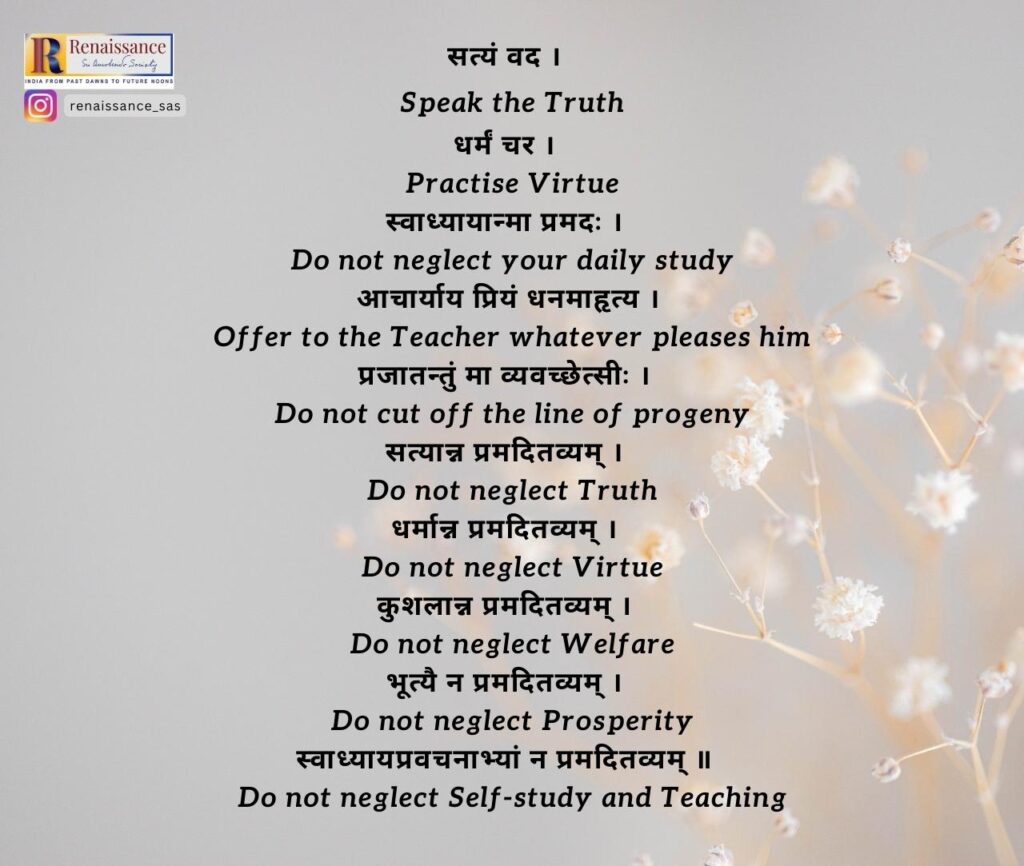
* * *
Once an individual marries and enters the householder stage of life, the discipline of brahmacharya takes the form of the virtues of moderation and fidelity. Additionally, and more importantly, in the context of householders brahmacharya is also seen as a way of engaging in sexual behaviour as a conscious, co-creative practice rather than merely as an unconscious habit to fulfill one’s lowest instinct. This also involves pursuing a lifestyle that includes dharmic living; spiritual practices such as meditation; study of scriptures; religious rituals etc.; and sincerely performing one’s duties toward the family and society.
READ:
Gṛhasthadharma: The Dharma of a Householder
Thus, brahmacharya is essentially a discipline for mastering one’s lower nature and self-preparation for pursuing the higher goals in life. This involves controlling one’s desires on all levels – physical, emotional and mental. It further involves developing a habit of detachment from the objects of desire.
Brahmacharya is also understood as purity in thought, word and deed. It is celibacy and continence. But it is not mere bachelorhood. It includes the control, not only of the sexual desire or impulse but also control or restraint over all other senses, in thought, word and deed.
In a series of essays titled, “The Brain of India” written in 1909, Sri Aurobindo explained the deeper significance of Brahmacharya as a foundation for education. He wrote that a right system of education must start with a sufficient knowledge of human constitution and psychology.
An education that confines itself to imparting knowledge, is no education. It must concern itself with the development of various faculties of memory, judgment, imagination, perception, and reasoning. These faculties build the edifice of thought and knowledge for the knower. This requires a strong foundation in the form of “a fund of force and energy sufficient to bear the demands of a continually growing activity of the memory, judgment and creative power.” (CWSA, Vol. 1, p. 370)
But where is that energy to be found? This is where we begin to understand the significance of Brahmacharya.
Psychological Theory Behind the Discipline of Brahmacharya
Let us read from Sri Aurobindo’s explanation in this regard.
At the basis of the old Aryan system was the all-important discipline of Brahmacharya. The first necessity for the building up of a great intellectual superstructure is to provide a foundation strong enough to bear it . . .
The ancient Aryans knew that man was not separate from the universe, but only a homogeneous part of it, as a wave is part of the ocean. An infinite energy, Prakriti, Maya or Shakti, pervades the world, pours itself into every name and form, and the clod, the plant, the insect, the animal, the man are, in their phenomenal existence, merely more or less efficient ādhāras of this Energy.
We are each of us a dynamo into which waves of that energy have been generated and stored, and are being perpetually conserved, used up and replenished. The same force which moves in the star and the planet, moves in us, and all our thought and action are merely its play and born of the complexity of its functionings.
There are processes by which man can increase his capacity as an ādhāra. There are other processes by which he can clear of obstructions the channel of communication between himself and the universal energy and bring greater and greater stores of it pouring into his soul and brain and body. This continual improvement of the ādhāra and increase in quantity and complexity of action of the informing energy, is the whole aim of evolution.
When that energy is the highest in kind and the fullest in amount of which the human ādhāra is capable, and the ādhāra itself is trained utterly to bear the inrush and play of the energy, then is a man siddha, the fulfilled or perfect man, his evolution is over and he has completed in the individual that utmost development which the mass of humanity is labouring towards through the ages.
If this theory be correct, the energy at the basis of the operation of intelligence must be in ourselves and it must be capable of greater expansion and richer use to an extent practically unlimited. And this also must be a sound principle, that the more we can increase and enrich the energy, the greater will be the potential range, power and activity of the functions of our mind and the consequent vigour of our intellectuality and the greatness of our achievement.
This was the first principle on which the ancient Aryans based their education and one of the chief processes which they used for the increased storage of energy, was the practice of Brahmacharya.
~ CWSA, Vol. 1, pp. 369-371
CONTINUED IN PART 2

~ Design: Beloo Mehra and Biswajita Mohapatra


